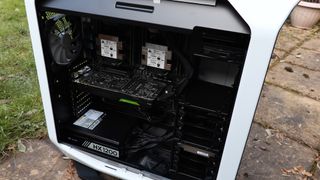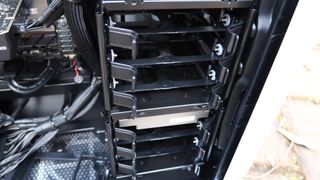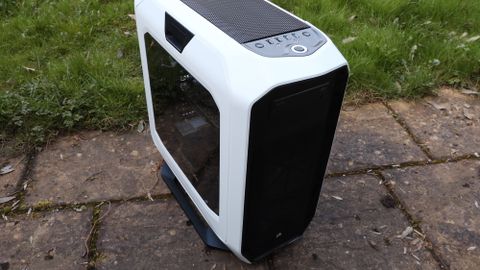IT Pro Verdict
The PC Specialist Axiom costs a fortune, but we’re unlikely to see a faster workstation for some years to come
Pros
- +
Fastest workstation rendering performance we’ve ever seen; excellent 3D modelling abilities; huge 12TB storage; plenty of storage upgrade potential
Cons
- -
Hugely expensive
PC Specialist has been making professional workstations for a few years now, but the company recently added a dual-socket option based around the latest Intel Xeon processors called the Axiom. We asked them to send us the most top-end specification available. What we ended up receiving could well be the most powerful workstation we will review all year, and probably for a few years to come.
PC Specialist Axiom: Processor and Memory
Scan 3XS VI4000 Viz review Armari Magnetar S16T-RW1000G2 review Workstation Specialists WS102LE review
The component that pushes this system into the performance stratosphere, or components (as there are two of them), is the processor. This workstation sports twin Xeon Platinum 8180 CPUs, which are currently the most potent workstation processors you can buy. Each has 28 cores, with Hyper-Threading, for a total of 56 threads. So this system can process 112 threads at the same time, which will make it an absolute monster for highly parallelised tasks like rendering.
In the past, the Intel Xeon processors with the most cores generally had a downside: they ran at very conservative clock rates. However, whilst the 8180 has a nominal frequency of a fairly pedestrian 2.5GHz, the top 3.8GHz Turbo mode for up to two cores is more competitive, and four cores can run at 3.4GHz. It can operate all 28 cores at up to 3.2GHz, and 20 cores at 3.5GHz. So the 8180 will be very capable at virtually any kind of task, whether single- or multi-threaded.
You do pay an enormous premium for the Xeon Platinum, however. Just one of these processors on its own will set you back around 9,000 including VAT, so the two we have here are responsible for the lion's share of the price of this system. The Xeon Platinum 8180, although seen here in dual-socket form, can be fitted in systems with up to eight sockets. That would provide 224 cores and 448 threads, but you're only likely to see this many in a server - and an exceedingly big one, at that.

Processors of this capability, with so many cores, need plenty of RAM to keep them fed with data to process, and PC Specialist has supplied a huge 256GB of 2,666MHz ECC Registered DDR4 memory. This is configured as eight 32GB DIMMs. Amazingly, this army of RAM doesn't take up all the slots on the ASUS WS C621E SAGE motherboard, which has 12 DIMM sockets and supports a colossal maximum of up to 768GB of memory.
PC Specialist Axiom: Graphics Acceleration
The Axiom doesn't go quite so all out where the graphics are concerned. The 5,000 NVIDIA Quadro P6000 is the current pinnacle of professional graphics acceleration, but it's a very specialised tool, aimed at simulations where its 24GB of frame buffer are essential. Instead, our Axiom includes the much more mainstream P5000. But this is still an extremely capable professional graphics accelerator, and a sensible choice for a workstation.
The NVIDIA Quadro P5000 uses the Pascal GPU generation and offers a very significant 2,560 CUDA cores. It sports a 256-bit memory interface to its 16GB of GDDR5 memory, offering 288GB/sec of bandwidth. This will allow it to handle huge texture sets. There are also four DisplayPort 1.4 connections plus Dual-Link DVI-D, and a bracket for stereo headset synchronisation.
This card supports a maximum single DisplayPort resolution of 7,680 x 4,320 at 30Hz with 30-bit colour and HDR, but 5K at 60Hz with 30-bit colour and HDR. With the huge amount of 3D acceleration available here, and support for massive texture sets, this is a great graphics acceleration choice for modelling high-resolution content on a large monitor.
If you need to add further graphics cards, there are two more full x16 speed x16 PCI Express slots on the motherboard, two more than can run with one at x16 or two at x8, and a further pair that run at x8 only. So you really can add a huge graphics array or a powerful GPGPU coprocessor configuration.
PC Specialist Axiom: Storage
The storage allocation continues the high-end specification, whilst following the usual configuration of an SSD for operating system and applications, alongside a conventional hard disk for general capacity. The SSD is a 500GB Samsung 960 EVO NVMe M.2 model, whilst the HDD is an absolutely enormous 12TB Seagate Barracuda Pro 7,200rpm SATA unit, which is currently the largest capacity available from a mechanical drive.

The Samsung SSD promises 3,200MB/sec reading and 1,900MB/sec writing. We only saw 2,825MB/sec reading and 1,813MB/sec writing using CrystalDiskMark 6, but that's still very impressive and the writing speed is close to the maximum for NVMe. The Seagate HDD is the fastest 7,200rpm drive we've seen in a workstation, registering 250MB/sec reading and 246MB/sec writing with CrystalDiskMark 6.
Just in case you need to install software from a DVD or burn a data disc, there's a 24x dual-layer DVD writer included as well. The hard disk cage has space for five more 3.5in drives, and there are caddies for three 2.5in drives behind this too. So there is plenty of room for storage upgrade.
PC Specialist Axiom: Chassis Design
Befitting the huge specification, the PC Specialist system comes in an absolutely enormous Corsair Graphite Series 780T full tower chassis. This is not your average black workstation obelisk, either. Instead, the primary hue is white, with easily unclipped panels on both sides. The main one is windowed, revealing the spacious layout, despite the plethora of components within.
Removing this panel provides easy access to all the main components. The 3.5in drive bays all use quick-release caddies, with a full complement included in our sample, although these are not hot swap, so you will need to gain access from the other side to hook up power and SATA cables. Fortunately, gaining access to this side is easy too. The non-windowed panel also provides access to the 2.5in drive caddies.
The top of the chassis sports two USB 2.0 and two USB 3.1 ports, plus headphone and microphone minijacks. The back panel provides a PS/2 keyboard or mouse combo port, two Gigabit LAN, two USB 3.1 Gen 2 (one Type-A, one Type-C), four USB 3.1 Gen 1, four USB 2.0, eight-channel analog audio plus S/PDIF, and a button to restore the previous BIOS should an update fail or new settings rendering the system unable to POST.
PC Specialist Axiom: Processor Performance
The CPUs are the star of the show in this system, and benchmark results bear this out. The headline result is in Cinebench R15 rendering, with an absolutely gobsmacking 7,170. This figure is almost twice as much as any other workstation we've tested, including 16-core models running at considerably faster clock speeds.

The IT Pro media benchmarks are equally impressive, with an overall score of 471.The imaging result of 163 shows that this system still offers great single-core abilities, but with 499 in video encoding and 554 in multi-tasking, anything requiring multi-core grunt will absolutely fly. These abilities continue in GeekBench 4, with a capable 4,536 single-core result but outstanding 29,221 multi-core score.
PC Specialist Axiom: Graphics Performance
The NVIDIA Quadro P5000 graphics are a step up from the P4000 in Dell's Precision 5820 (https://www.itpro.com/hardware/30704/dell-precision-5820-review-a-solid-all-rounder-but-it-s-not-cheap) that we reviewed recently. This GPU provides top-end acceleration for every type of 3D content creation software.
The score of 215.47 in Maxon Cinebench R15 is beaten by systems with faster processor clock speeds, as this test is very sensitive to CPU frequency, but is still a great result. With 141.36 in SPECviewer 12.1's 3dsmax-05 and 106.94 in maya-04, you're getting great 3D animation abilities across the range of applications. The result of 190.02 in sw-03 shows excellent engineering and product design too. However, GFXBench 4 achieves 2,952.35 onscreen and 18,221.2 offscreen in Car Chase, plus 3,097.75 onscreen and 23,082.7 offscreen in Manhattan, which are good but not outstanding.
There's plenty of GPGPU grunt available here, however, with 2,560 CUDA cores on tap. The P5000 achieves a considerable 3,490 in LuxMark 3.1, and 127.51 in OctaneBench 3. In other words, OpenCL- and CUDA-accelerated software will gain considerable benefit.
PC Specialist Axiom: Verdict
There really isn't a weak area for the PC Specialist Axiom, which is what you would hope for from a system costing over 20,000 plus VAT. Of course, you can create much more sane and affordable specifications, but this Axiom is the most powerful workstation we have ever tested for CPU-intensive tasks like rendering, and it's very handy for 3D modelling as well. It really showcases what the Intel Platinum 8180 processor is capable of, assuming you have the cavernously deep pockets required to afford it.
Verdict
The PC Specialist Axiom costs a fortune, but we’re unlikely to see a faster workstation for some years to come
| Processor: | 2 x 2.5GHz Intel Xeon Platinum 8180 |
| RAM: | 256GB 2,666MHz Registered ECC DDR4 |
| Graphics: | 16GB GDDR5 NVIDIA Quadro P5000 |
| Storage: | 500GB Samsung EVO 960 NVMe SSD;12TB Seagate Barracuda Pro 7,200rpm SATA HDD |
| Operating System: | Windows 10 Professional 64-bit |
| Warranty: | 3 years (1 month collect and return, 1 year parts, 3 years labour) |
| Website: | https://www.pcspecialist.co.uk/computers/intel-lga3647-workstation/ |
SPECviewperf 12.1 Results
| 3dsmax-05 | 141.36 |
| catia-04 | 186.69 |
| creo-01 | 123.42 |
| energy-01 | 18.61 |
| maya-04 | 106.94 |
| medical-01 | 78.15 |
| showcase-01 | 102.76 |
| snx-02 | 204.73 |
| sw-03 | 190.02 |
Dr James Morris has worked as a technology journalist for over 25 years, including spending nine years on the staff of market-leading computer magazine PC Pro, the last five of which were as the publication’s editor. He specialises in enterprise-grade software and hardware, with a particular focus on content creation. He launched a pioneering video channel for HEXUS.net in 2006 and ran the video reviews channel for TrustedReviews.com for four years. He also runs a successful online digital content and commercial video production company, t-zero communications Ltd.
Dr Morris is a prolific technology writer and contributes commercial content for major IT brands including AMD, BlackBerry, Dell, Cognizant, HP, and IBM. He published a book on artificial intelligence, Can Computers Create Art? in 2009. He is also an academic, and is currently Pathway Director of the MA, Interactive Journalism at City, University of London.
Previously, he was course leader for the BA in Web Media Production at Ravensbourne University. He has a PhD in Philosophy, Art and Social Thought from the European Graduate School in Switzerland, a Master's in Media Arts from the New School in New York, USA, and a Bachelor's in Social Anthropology from the London School of Economics.
Dr. Morris can be found on Twitter at @Cyberwest, or emailed at j@tzero.co.uk



